Friday – Tuesday, January 13-16, 2024 – IT TOOK MANY YEARS TO BUILD A BOARDWALK


FROM THE ARCHIVES
FRIDAY – TUESDAY
JAN. 12-16, 2024
Building Coney Island’s
Centerpiece –
The Boardwalk
STUART MARQUES
NEW YORK CITY MUNCIPAL ARCHIVES
ISSUE# 1163
Through the ups and downs of nearly 100 years, Coney Island’s boardwalk has been the beachfront spot for untold millions to stroll, catch some sun, meet friends, munch hot dogs, or just look out at the water. And, like all big new projects in New York City, bringing the boardwalk to life hit snags and was kicked around as a political football while its cost went up and work moved more slowly than expected.
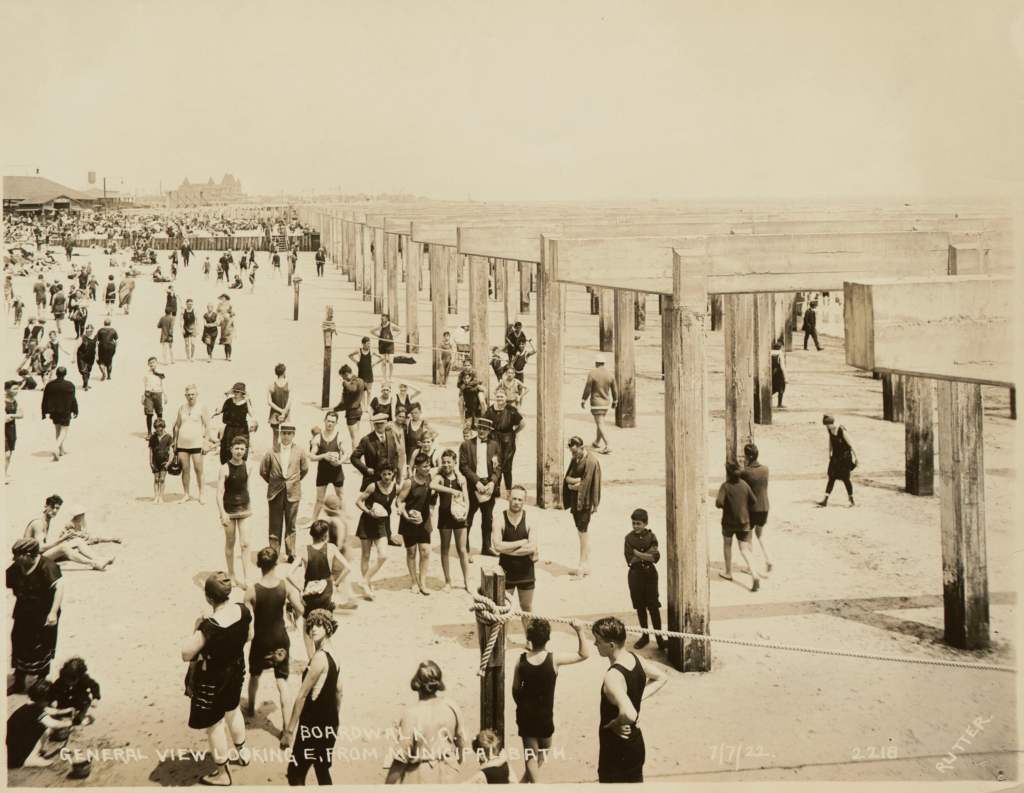
Boardwalk, Coney Island, general view looking east from Municipal Bath, July 7, 1922. Photographer: Edward E. Rutter. Borough President Brooklyn Collection. NYC Municipal Archives.
The first serious talk of building a public boardwalk came in the 1890s, when Coney Island was transitioning from a private playground for the rich – with giant fences preventing public access to the beach – to a place of fun, leisure and a little weirdness for all.
The Municipal Archives holds some 200 pictures of what was originally known as the Coney Island Boardwalk, including dozens of the construction in 1922 and 1923. Newspapers of the day, especially the old Brooklyn Daily Eagle, tell the story.

Boardwalk, Coney Island, general view, looking west from Martino’s Bath, July 7, 1922. Photographer: Edward E. Rutter. Borough President Brooklyn Collection. NYC Municipal Archives.
While the idea of a public boardwalk was debated for years, planning didn’t begin in earnest until August of 1912. The West End Improvement League, consisting of merchants and developers, launched a campaign to build the promenade, starting a local newspaper and mailing 12,000 postcards to politicians, business owners and influencers. Although there was strong public support locally, landowners along beachfront area fought the proposal bitterly and tried to find friendly lawmakers to stop it.
On October 24, 1912, the Eagle reported on the first legal salvo in the war to build a boardwalk: “State Sues to Win Back Coney Island Beach for the People,” the headline screamed. “Demands Removal of Obstructions Preventing Free Passage for Purposes of Bathing, Boating and Fishing.” The story reported that State Attorney General Thomas Carmody had filed suit against the owners of the Steeplechase Company and other landowners, claiming the beach belongs to the public and branding the fencing and barriers “a public nuisance.”
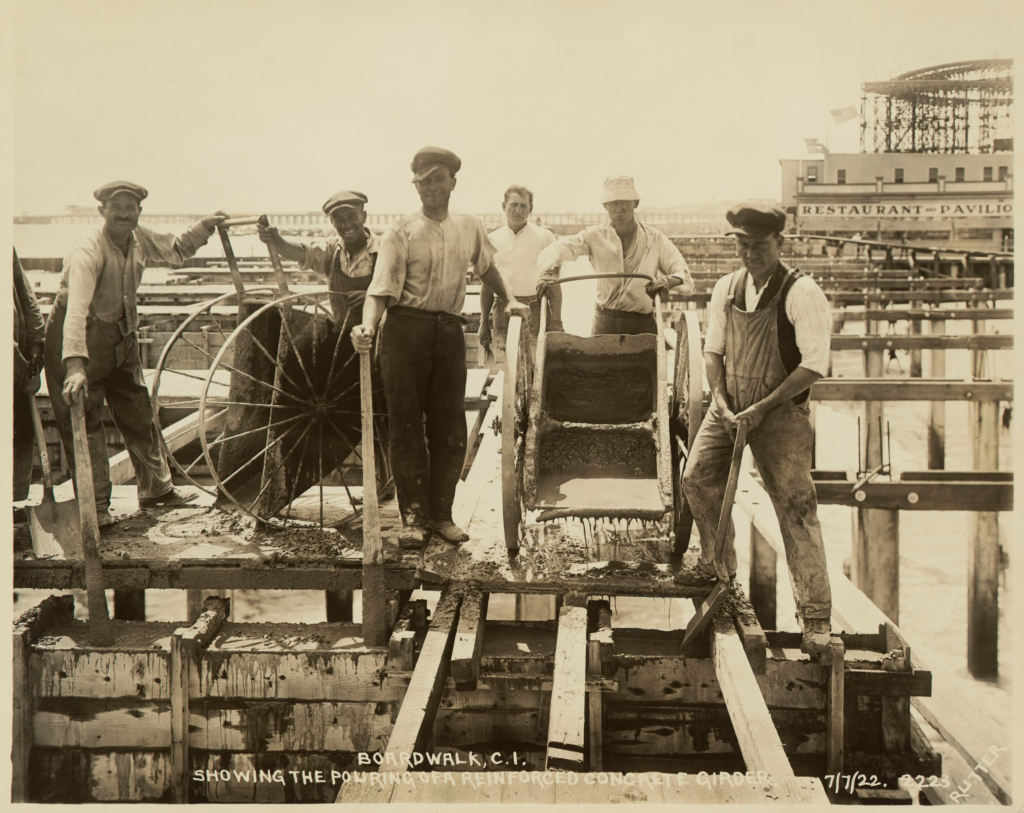
Boardwalk, Coney Island, general view showing pouring of a reinforced concrete girder, July 7, 1922. Photographer: Edward E. Rutter. Borough President Brooklyn Collection. NYC Municipal Archives.
A lawyer for the owners, claimed they had a legal right to the beachfront land and said, “…we certainly intend to fight the state’s claim to the finish.” The “finish” came rather quickly: A judge upheld the state’s claim in 1913 and the Court of Appeals affirmed it in 1916.
Political wrangling in the State Legislature delayed progress for several years, but on August 22, 1920, The Brooklyn Eagle optimistically reported: “Coney Island Boardwalk to be Completed by 1921.” Brooklyn Borough President Edward Riegelmann, an “energetic booster” of the plan had laid out details earlier that month.
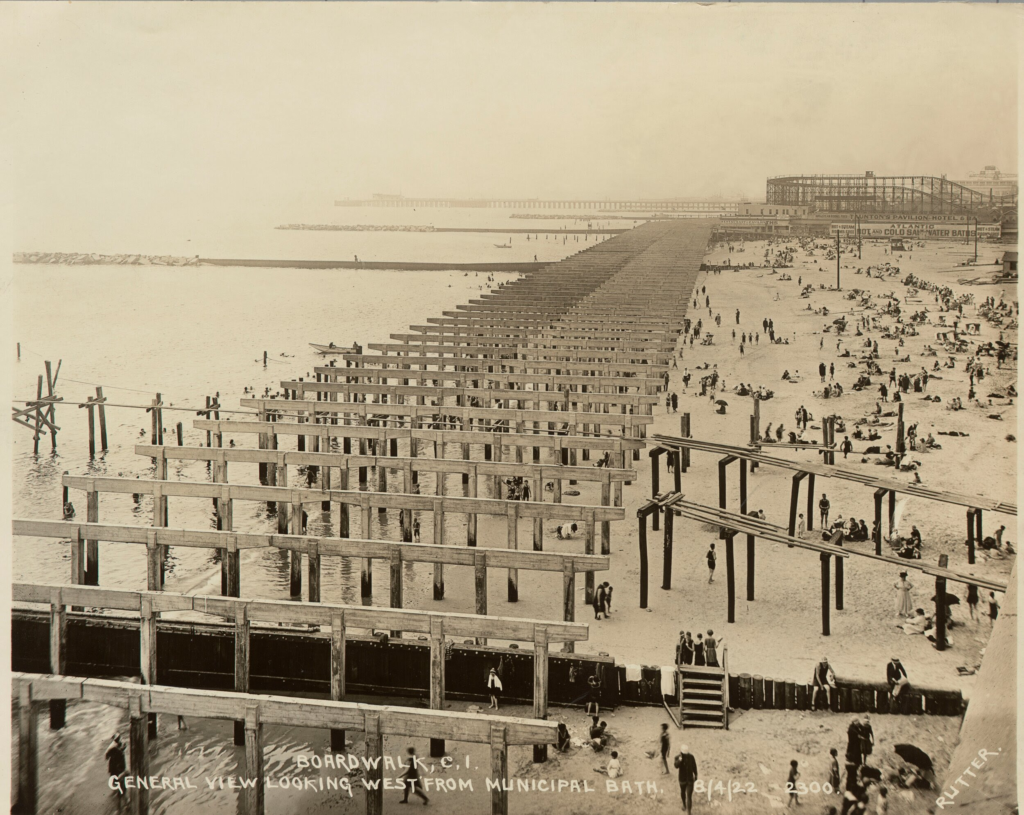
Boardwalk, Coney Island, general view, looking west from Municipal Bath, August 4, 1922. Photographer: Edward E. Rutter. Borough President Brooklyn Collection. NYC Municipal Archives.
Riegelmann, who some dubbed the “Father of the Boardwalk,” said it would be 80 feet wide and two miles long running from Ocean Parkway to Sea Gate. He estimated the boardwalk would be built at a cost of $4 million (more than $50 million today). It would use 1.7 million cubic yards of sand, 110,000 tons of stone, and 7,700 cubic yards of reinforced concrete. Workers would build 16 rock jetties spaced 600 feet apart to protect the boardwalk from violent waves, while others drove 28-foot-long piles 19 feet deep into the sand. But the political wrangling continued even before the first shovel hit the ground. On Jan 6, 1921, the Eagle reported that the plan had hit “a $7 million snag,” the amount the owners claimed they would lose in property values – perhaps the first sign that the boardwalk would not be completed in 1921.
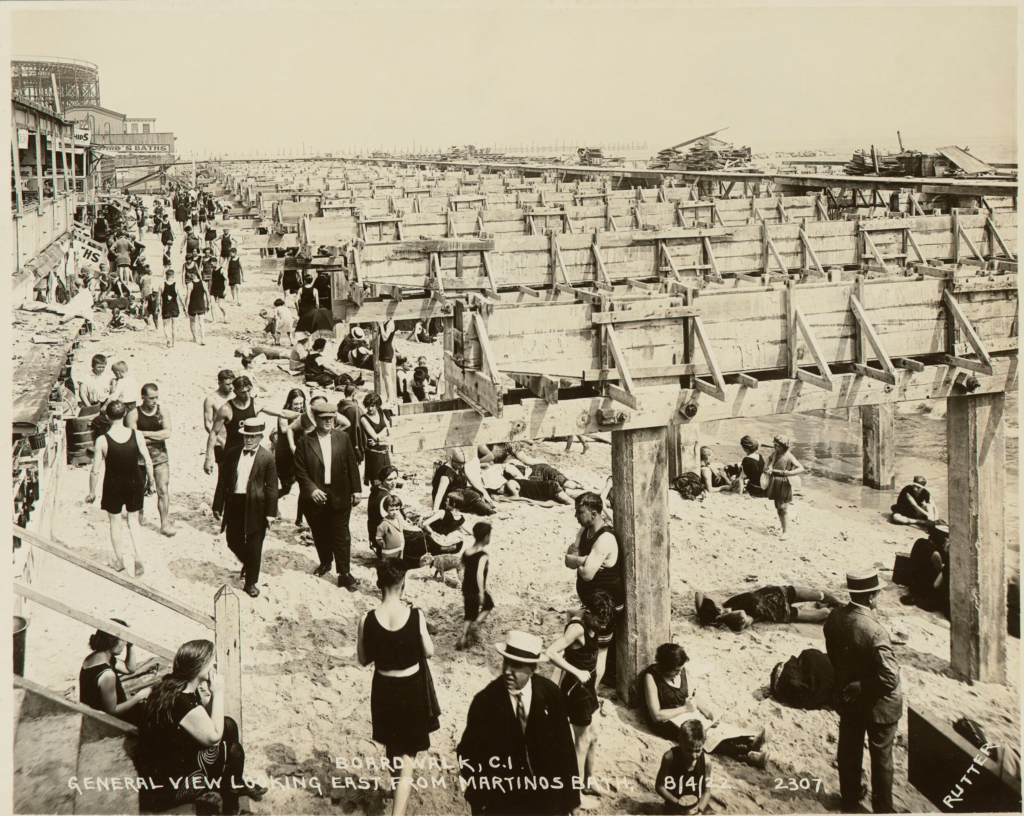
Boardwalk, Coney Island general view, looking east from Martino’s Bath, August 4, 1922. Photographer: Edward E. Rutter. Borough President Brooklyn Collection. NYC Municipal Archives
Five months later, a fight erupted over whether to use timber or concrete for boardwalk supports. Advocates for the use of concrete argued that wood would not be “permanent” and would have to be replaced or shored up from time-to-time. Wood supporters argued that concrete was much more expensive than creosoted timber and noted that wooden trestles under the LIRR’s Jamaica route were still in good condition after many years and that the first concrete-supported Santa Monica Pier had “gone to pieces” in just a few years. Concrete won the day.
Undeterred by the delays, a long story in the July 3, 1921 edition of the Brooklyn Eagle breathlessly – though erroneously – reported: “Coney Island is to Replace Atlantic City as Society’s Playground, is Prediction.” The story began: “If the prediction of the Coney Island Boardwalk enthusiasts should be verified in the not distant future, the sad waves will murmur ‘Good night’ to Atlantic City and gently rock that out-of-date seaside resort to sleep … Good-bye hot dog; Good-bye chamber of horrors; Good-bye museums of monstrosities …”
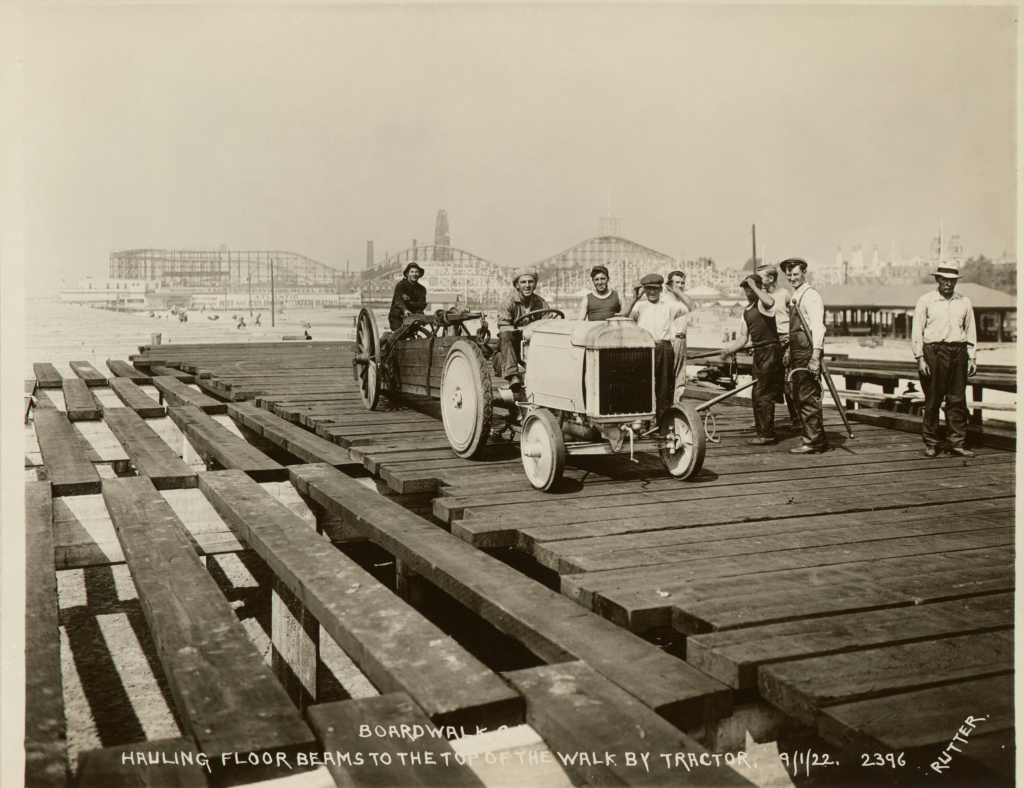
Boardwalk, Coney Island hauling floor beams to the top of the walk by tractor, August 4, 1922. Photographer: Edward E. Rutter. Borough President Brooklyn Collection. NYC Municipal Archives.
Boardwalk construction finally began in 1922, with wooden planks in a chevron pattern atop the concrete and steel bearings. The first section, from Ocean Parkway to West 5th Street, opened to the public in October 1922. The second section, from West 5th Street to West 17th Street, opened with pomp and a ribbon-cutting on Christmas Eve of 1922 attended by Borough President Reigelmann and thousands of celebrants.
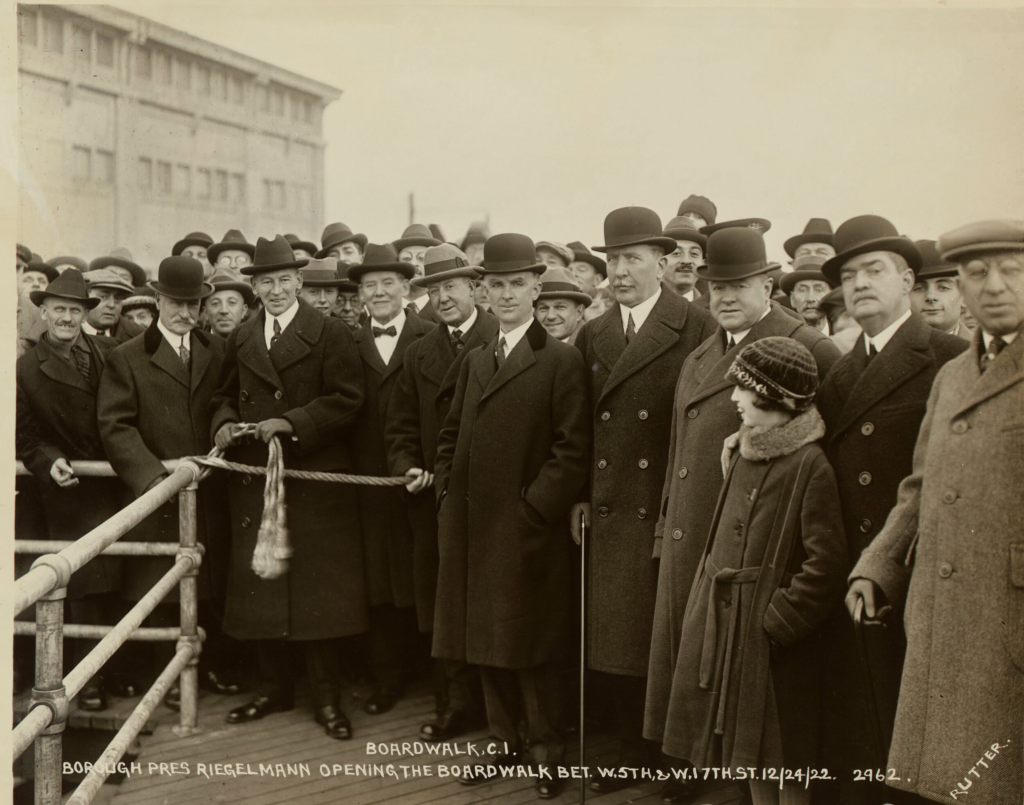
Boardwalk, Coney Island, Borough President Riegelmann opening the Boardwalk between West 5th and West, December 24, 1922. Photographer: Edward E. Rutter. Borough President Brooklyn Collection. NYC Municipal Archives.
The city held a formal opening of the entire boardwalk – which was re-named the Riegelmann Boardwalk – in May 1923. Some mildly amusing controversy continued: In June 1923, the Eagle reported that 25 people plead guilty and were fined $25 each for violating a public ordinance by strolling along “only in their bathing suits.” And that August, there were complaints that mothers were bringing their children to benches on the boardwalk to eat, leaving food scraps and refuse on the boardwalk – and that amorous couples were “spooning” on the benches.
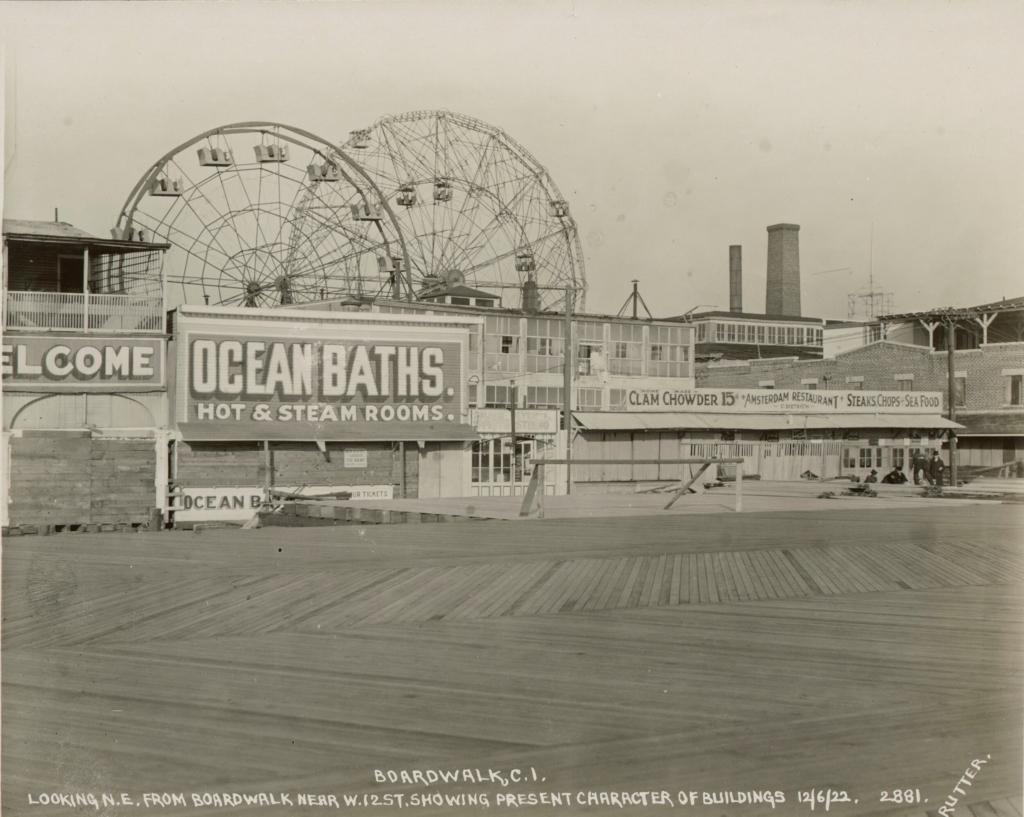
Boardwalk, Coney Island, looking northeast from Boardwalk, near West 12th Street, showing present character of buildings, September 6, 1922. Photographer: Edward E. Rutter. Borough President Brooklyn Collection. NYC Municipal Archives.
The boardwalk would be repaired many times over the years and, in 1938, under City Parks Commissioner Robert Moses, parts of it were expanded, straightened, and relocated 300 feet inland. He tried to expand it again into Manhattan Beach, but that plan was defeated.
The city declared the Riegelmann Boardwalk a landmark in 2018.
TUESDAY PHOTO OF THE DAY
SEND YOUR RESPONSE TO:
ROOSEVELTISLANDHISTORY@GMAIL.COM

PHOTO OF THE DAY
CREDITS
ROOSEELT ISLAND HISTORICAL SOCIETY ARCHIVES
NYC MUNICIPAL ARCHIVES
JUDITH BERDY
MAYA LEVANON-PHOTOS TIK TOK & INSTAGRAM
All image are copyrighted (c) Roosevelt Island Historical Society unless otherwise indicated
www.tiktok.com/@rooseveltislandhsociety
Instagram roosevelt_island_history
THIS PUBLICATION FUNDED BY DISCRETIONARY FUNDS FROM CITY COUNCIL MEMBER JULIE MENIN & ROOSEVELT ISLAND OPERATING CORPORATION PUBLIC PURPOSE FUNDS.


Copyright © 2024 Roosevelt Island Historical Society, All rights reserved.Our mailing address is:
rooseveltislandhistory@gmail.com

Leave a comment